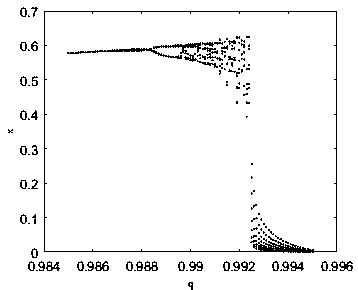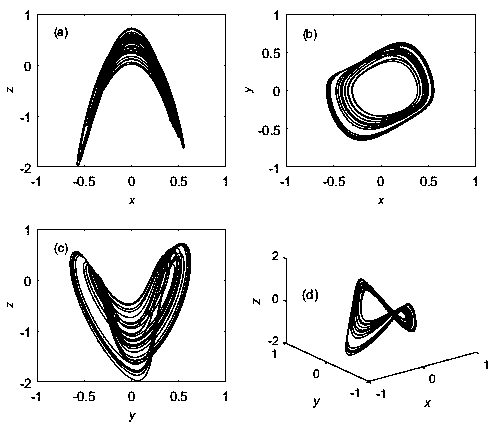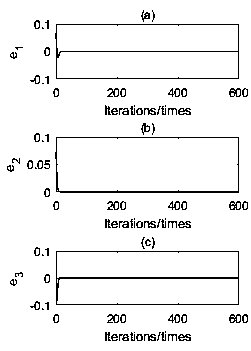Fractional order hidden chaotic system with linear balance point
A fractional-order system, chaotic system technology, applied in digital transmission systems, transmission systems, secure communication through chaotic signals, etc., can solve the optimization without considering time, ignoring time finiteness, only emphasizing system robustness and other problems, Achieve the effect of limited time synchronization and rich diversity
- Summary
- Abstract
- Description
- Claims
- Application Information
AI Technical Summary
Problems solved by technology
Method used
Image
Examples
Embodiment 1
[0044] The fractional-order hidden chaotic system with a linear equilibrium point involved in this embodiment specifically includes the following steps:
[0045] Step 1: First give the definition of the Caputo fractional derivative:
[0046]
[0047] Where q is the order of the differential operator, t and A are limits, w is the smallest positive integer, w-1<q<w. Γ(*) is a gamma function, and f(*) is a continuous function.
[0048] The relevant properties of Caputo fractional differential are as follows:
[0049] Property 1: We consider general fractional differential equations
[0050]
[0051] The general solution of the equation is
[0052] x(t)=x(0)E q (At q ), (3)
[0053] and the Mittag-Leffter function is
[0054]
[0055] Then according to the finite-time stability theory of fractional order systems, the following Lemma 1 and Lemma 2 are introduced.
[0056] Lemma 1: For a general fractional order system, if it satisfies
[0057]
[0058] where x=...
Embodiment 2
[0070] The fractional-order hidden chaotic system with linear equilibrium points involved in this embodiment, based on the finite-time stability theory of fractional-order systems, designs a finite-time synchronous controller and a combined synchronous controller for fractional-order systems with hidden attractors.
[0071] Finite-time synchronization: Assuming the driving system is formula (8), the response system is as follows:
[0072]
[0073] Wherein, m=0, n=0. let e 1 =x 1 -x,e 2 ==y 1 -y,e 3 =z 1 -z,q=0.99, the error system is
[0074]
[0075] Then we get the following theorem.
[0076] Theorem 1: For the error system (11), we design the finite-time synchronous controller as
[0077]
[0078] Among them, k 1 and B 1 is the scaling parameter, the error system (11) in finite time t 1 converges to zero, and
[0079]
[0080] Proof: From Lemma 1, we get
[0081]
[0082] According to formula (7), we get
[0083]
[0084] Therefore, we come t...
Embodiment 3
[0120] In the simulation, in order to observe the chaos synchronization between different initial values of the fractional order chaotic system, the finite time synchronization and combined synchronization are studied by using the predictive correction method. For finite-time synchronization, the total number of iterations is 600, and the order of all fractional-order systems is q = 0.99. The initial value for finite-time synchronization is [x(0) y(0) z(0) x 1 (0)y 1 (0)z 1 (0)]=[0.1 0.5 0.5 0.2 0.6 0.4], according to formula (5), get
[0121] Such as Figure 3-4 , limiting the total number of iterations to 600 for clean results, e 1 ,e 2 ,e 3 converges approximately to zero at the 12th iteration, while x-x 1 ,y-y 1 ,z-z 1 Simultaneously achieve synchronization. The results show that the errors between the drive system and the response system converge to zero without considering the calculation error, and the error system is gradually stable within a finite time....
PUM
 Login to View More
Login to View More Abstract
Description
Claims
Application Information
 Login to View More
Login to View More - R&D
- Intellectual Property
- Life Sciences
- Materials
- Tech Scout
- Unparalleled Data Quality
- Higher Quality Content
- 60% Fewer Hallucinations
Browse by: Latest US Patents, China's latest patents, Technical Efficacy Thesaurus, Application Domain, Technology Topic, Popular Technical Reports.
© 2025 PatSnap. All rights reserved.Legal|Privacy policy|Modern Slavery Act Transparency Statement|Sitemap|About US| Contact US: help@patsnap.com



